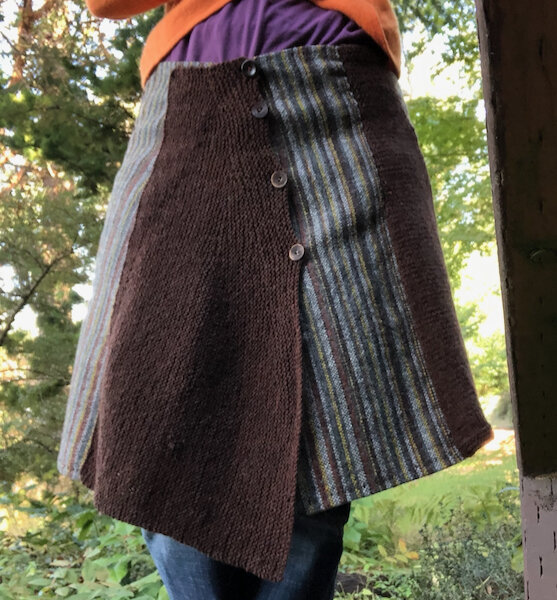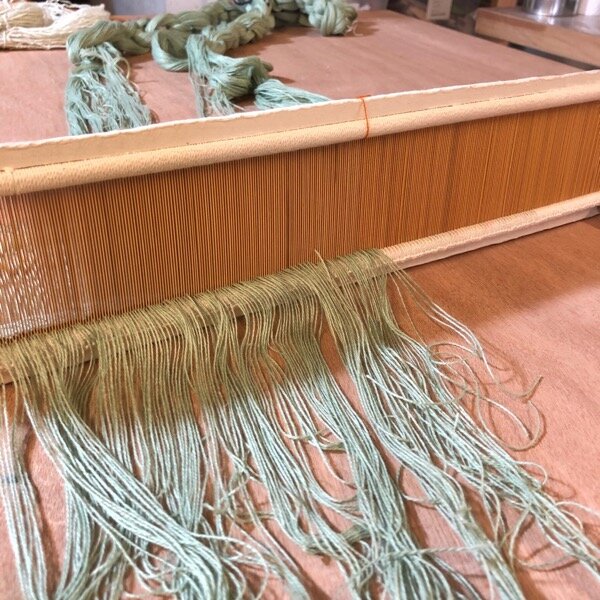This tiny snail was on the stem of my CSA broccoli, and I remembered I have a camera with a good macro setting. So I was diverted by looking at the snail and taking lots of photos as it scooted around on the stem. I called this one Snail Side-eye. That shell! The delicacy was entrancing. The shell is only about 1/4” wide, maybe 5mm.
You know that thing I said last time about how once I’ve finished something, it already seems old? That may be one reason why it’s hard for me to get around to sharing Finished Object photos. The other is the distraction factor, because the thoughts and images that elbow their way to the front of the queue are never exactly what I thought I might intend to talk about. Witness, the tiny snail.
But anyway, this weaving is finished, except for the fringe/edge treatment. I’m still undecided on what I’m doing at each end, but here’s three panels, joined with figure 8 stitch. It has been incorporated into the textile array in the low seating area that we call the majlis, our couch, where I am currently ensconced among weavings and pillows.
Bedouin style weaving, from handspun Navajo churro wool, 3 panels stitched together.
Now, I meant to include this next item with the petticoat details in the last post, because they are related. The Sarah-dippity skirt is, at long last, finished. The picture below is from nearly a year ago (this has been a long-running project). I tried it on when I had finished knitting the panels and put buttonholes in the last panel, whose shaping was made with short rows - and yeah, I could use some short row shaping finesse, but I decided what’s a little hem wonk among friends?
Backing up as I realize I may never have shared the in-progress bits, possibly because I was waiting until it was finished…..? Sigh. However, this is backstrap-woven fabric, begun in October 2019, 100% Harrisville Shetland wool yarn in a random stripey warp that was a bit of a circus act to wind, but satisfying to weave. I knit the intervening panels with the same yarn, using up the dark brown cone. I was sewing the panels together in February 2020, prior to knitting the final front piece. My waist-to-hip ratio required some more radical deductions in fitting the wedges to the straight pieces, which added to the delay in getting through that phase.
Shetland wool stripes in progress on backstrap loom, leather backstrap of unknown origin in foreground. Handmade bamboo reed in use.
Shetland wool striped fabric finished - about 8 x 100'“
What the skirt really needed, to be finished, was some elastic in the back half of the waistband, which I inserted in a sleeve of brown wool, a remnant from my lovely long skirt. And the buttons were pulling at the knitted fabric, so I wanted to add button bands. Another job for my new best friend, handwoven tape! I had some handspun tussah silk yarn in appropriate colors handy, and got to work. the cool thing is, being custom-made, the tape has woven-in buttonholes.
Hanspun tussah silk yarn, in natural, rust, and bronze.
I kept the skirt in my lap as I wove the buttonhole band, and buttoned each button as I went, so that the length between would be correct.
The skirt has already been recruited into use, but I don’t have fully-done photos yet. I’m sure you’ll see it underneath some weaving in progress eventually.
Meanwhile, how about some sleeve gussets? The next FO is actually a radical mending, or a reboot. A linen dress I’ve had for a very long time, love dearly, and never liked the fit of the sleeves. In sewing a linen shift, I learned a thing or two about gussets, and I wanted to apply that to this dress. But the sleeves were joined into the princess cut in such a way that merely adding gussets in the underarm was not enough. I had to cut the whole sleeve off and insert a wedge at the shoulder.
The linen dress on my work table, one sleeve reconfigured. The original sleeve is angled so low that anytime I raised my arms, it was too tight around the upper arm. Simply adding room below did not solve this problem - I had to reduce the angle from the shoulder, make it nearly straight out.
I’d been searching for linen of a harmonious color for these insertions, but my smart friend Ann suggested using a print fabric that shows right up, and carrying the insert all the way to the sleeve hem. Which sent me stash diving and gave me the joy of using more long-held fabrics to not only enhance function but jazz up this dress.
Whee, freedom of movement! I’ve worn it many a day since making this change. Seen here with a necklace made of weaving-enhanced driftwood, work of my friend Tininha.
It’s interesting to think about what counts as ‘finishing’ in my little textile world. I meant to show things that are done, wearable, no more work left until they need mending. But I realized that each plied ball of handspun yarn is also a small finished object. There are many stages of finishing, and the sense of accomplishment comes whenever I wind off a ball or a skein of yarn.
Four balls of handspun yarn, from top left cotton 2 strand plying ball, Corriedale plied, Coopworth 2 strand plying ball, Gnomespun dyed Gotland 2 strand plying ball. All of these have been plied since the photo - woot!
My life is filled with balls of yarn like this. And I never know what will strike me when sorting, or moving, or plying, or grouping them. As it happened, I went through the main ‘weaving yarn’ bin the other day, and found the Syrian silk in there. This stuff is heavy, in more ways than one. It has weight. Just holding three skeins’ worth was like a presence - I held them against my stomach, as if carried in the womb, and I remembered the market in Damascus. The Souq al Hamidiyyeh, a huge covered arcade of market stalls where I searched for the yarn shop a friend in Doha recommended.
I was there the end of February, 2011, only months before the rapid disintegration of what was then normal life for Syrians. It is sobering to think of these places now, and the yarn holds all of that.
Shelves of the yarn shop where I bought my silk, Souq al Hamidiyyeh, Damascus, Syria.
I wove some of this silk once before, along with some textured corespun yarn in the warp and an additional wool yarn in the weft. The resulting scarf was sold to a friend at an art fair in Doha.
Handspun yarn and Syrian silk scarf, modeled on the roof of my Doha apartment, 2011.
As I realized then, this silk (I call it silk, it may have some viscose in it, but they said it was silk, even when my Arabic speaking friend bought it,) needs something to stabilize it, something less slippery and lighter weight. It occurred to me to try weaving it with plain, white, handspun wool. This juxtaposition of flashy, shiny, bling yarn and earth-grown, undyed sheep’s wool parallels what I encountered in Arab culture. There is a deep history of pastoral connection to land, animals, and hand-worked materials, which coexists with a love of gold, sparkling jewels, and lush adornment. Very broad strokes here, but I could give examples if this post were not already getting lengthy. Suffice to say, this combination felt right, as an honoring of the yarn’s place of origin.
Syrian silk yarn and handspun CVM/Romeldale cross wool from Bellingham, WA.
I probably want to make something large-ish, as the yarn allows, but first I needed to sample my idea. I spent much of a day working up this sample, and I can’t even express how much I adore the fabric.
Sunlight on weaving in progress.
The sun was shining on this day, and I enjoyed the glint of sunlight on silk immensely, broken up with all the little dashes of wooliness.
A small sample, a tiny little piece of fabric, but I love everything about it, the hand, the texture, the rhythm of bright and matte surfaces, and the way the light shines through.
The rug in the background is also from Syria, bought on the same brief visit. Through my own weaving, my heart honors and hopes for the place and the people, that they (and we all) may thrive in some new form.
























